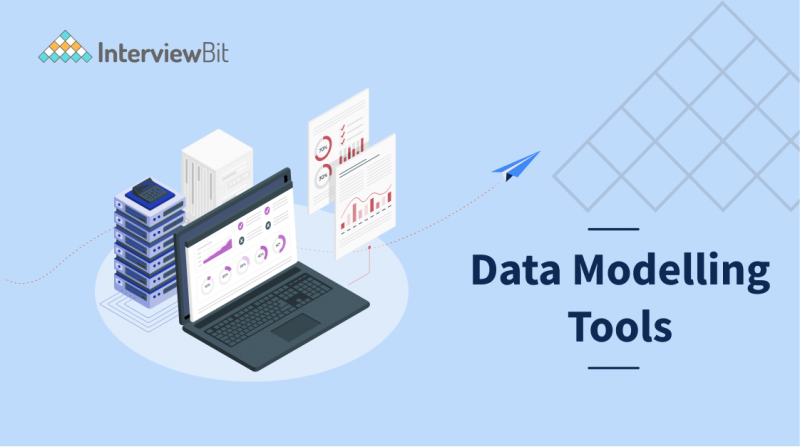- What is Data Model?
- Types of Data Models
- What are Data Modeling Tools?
- Uses of Data Modeling Tools
- Data Modeling Tools
- 1. Archi
- 2. Database Deployment Manager
- 3. dModelAid
- 4. ER/Builder Data Modeler (ER: entity-relationship)
- 5. SQL Database Modeler
- 6. DbSchema
- 7. Edraw Max’s Database Model Diagram
- 8. Draw.io
- 9. PowerDesigner
- Conclusion
- FAQs
What is Data Model?
Data can be modelled at different levels of abstraction. The process commences by accumulating information about business requirements from stakeholders and end-users. These business rules are then transcribed into data structures to devise a concrete database design. A data model can often be regarded as a roadmap, an architect’s blueprint, or any formal diagram that promotes a deeper understanding of what is being devised. The process of designing a simplistic diagram of a complex software system is termed data modelling. The design can be used to guarantee the effective use of data as a blueprint for the development of new software or for reengineering a legacy application.
Ideally, a data model can be thought of as a flowchart that explains the connections among pieces of data. It allows stakeholders to distinguish flaws and implement corrections before programming code is written. Alternatively, models can be designed as part of reverse-engineering efforts that extract models from existing systems, as seen with NoSQL data. Data modelling is an essential skill for data scientists, data analysts, and others associated with data analysis.
Types of Data Models
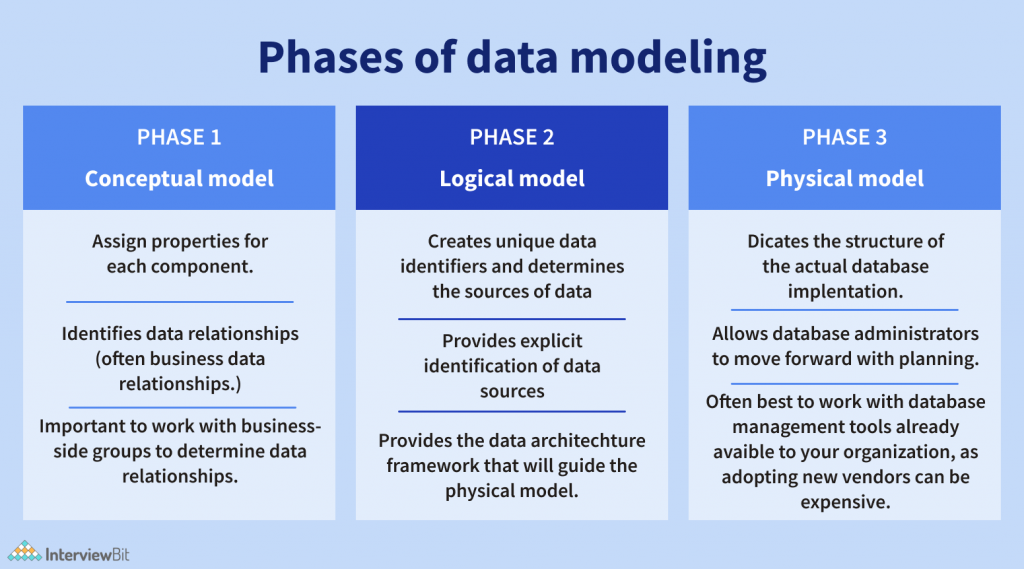
- Conceptual Data Model – This particular model is a high-level representation of a database design that explains how data interrelate and what kind of data should be stored in the database. The intended audience for conceptual data models is the business side of an organization. The conceptual data model describes the data structure, which the business requires. Once the conceptual data model is designed, it can be improved and transferred into a logical data model.
- Logical Data Model – These models are used to build the database structure and explain the data from a technical perspective. The technical front of an organization uses logical data models as detailed depictions of database designs. This data model serves as the basis for the creation of a physical data model.
- Physical Data Model – This data model is specific to the application and database to be incorporated. It is used to design the tables and fields that store database data. A physical data model represents a database design for a specific database management system (DBMS). Both the technical and business sides of an organization use this type of model.
What are Data Modeling Tools?
Businesses need accurate and credible data to make decisions for better functioning. Even a small mistake can cause the data to go unreliable and unsuitable for decisions. Counting on such unreliable data can result in losses.
Confused about your next job?
Data modelling comes as a saviour here. A data modelling tool can design a data model to store the data in a database. These tools can make use of diagrams of data flow to create a database so that you can get the desired structure you need.
Uses of Data Modeling Tools
Listed below are a few practical uses of Data Modelling tools in any sector or industry.
- Data Modelling tools help create a robust design with a data model which can depict an organization’s complete data on the same platform.
- The tools make sure that all the data objects needed by the database are represented or not and better consistency can be achieved with the help of a data model across all the projects.
- The database at the logical, physical, and conceptual levels can be devised with the help data model.
- The relation tables, primary keys, and foreign keys can be defined with the data model’s help.
- Data Modelling Tools aid in the improvement of data quality and though the data model is quite time-consuming, but it makes maintenance cheaper and faster.
- Data Model gives a clear picture of business requirements.
- Redundant and missing data can be identified with the help of the tools.
- In data models, all the important data is accurately represented. The chances of inaccurate results and faulty reports decrease as the data model reduces data omission.
- The data models formulate a visual representation of the data. With the help of it, data analysis can be improved.
Data Modeling Tools
There are ample data modelling tools out there. In this article, we’ll take a look at the ten best options.
1. Archi

The Archi modelling toolkit is an open-source data modelling tool made to target mostly all levels of Enterprise Modellers and Architects.
Features
- Archi is used globally by insurance companies, banks, industry, EA consultants, universities, and students.
- It offers a low-cost-to-entry solution to users who have just started their journey in the ArchiMate modelling language, or who are eyeing an open-source, cross-platform ArchiMate modelling tool to run their company.
- It is presumably the most popular ArchiMate modelling tool. Archi supports the most advanced version of the ArchiMate 3.1 language.
- With the help of Archi, you can easily and intuitively design all ArchiMate elements in all of the ArchiMate views.
- You can also use the magic connector to devise the correct connections between ArchiMate concepts.
2. Database Deployment Manager
Database Deployment Manager (DDM) tool designs database structures (queries, tables, etc.) using an object-oriented methodology. Object-oriented modelling devises table templates that explain the structure of a table. It also creates instances of the table template which is used to physically create the tables in the database. DDM is distributed as free software under the LGPL License.
Features
- With the help of Object-Oriented modelling design, table templates describe the structures of a table and create instances of the table template, which can be used to physically construct the tables in the database.
- Devise E-R diagrams between the selected tables, and export these as graphics or SVG
- Load or save startup data for tables from CSV files
- Database design validation
- SQL script generation towards a target database engine and parallel deployment into selected databases
- Unique visual query builder
- Browsing a current database, importing tables into the solution
- Version management and record variations of database tables
- Documentation generator
- Reverse engineer a database
3. dModelAid

dModelAid, the ideal modeling tool is used for documenting a complex database design in a more simplistic, interactive diagram. It assists you to recover considerable volumes of records from the database using SQL queries.
Features
- The software allows smart visualization features for devising the DB structure. You can visualize a table with tables with keys, indexes, and relationships.
- dModelAid supports reverse and forward engineering. Forward Engineering implies transitioning from a logical data model to a physical data model. This is easy as the design incorporates all dependencies, relationships, and indexes, between the components of the data model. On the other hand, Reverse Engineering implies Attempting to reconstruct the logical data model from a physical data model.
- It is packed with intuitive tools like fast search, template projects, and naming conventions, and helps recognize possible errors before you write any code.
- One can design a project with Microsoft SQL Server, SQLite orvOracle, MySQL, and change the database at any time with automatically built-in data type mappings.
- The project is documented automatically, enabling to keep track throughout project versioning and making the learning process for the team members much easy.
4. ER/Builder Data Modeler (ER: entity-relationship)

The software is best suited for both novices and experts. It allows database engineers to design DBs graphically with the help of physical designs to generate popular SQL DBs. Visualized structures help them learn about existing DBs, create new ones, and modify, interpret, and optimize solutions. A sophisticated visual data modelling environment allows one to deploy the databases. ERBuilder Data Modeler can easily figure out plausible mistakes and ambiguities in the created model.
There are 3 ways in which you can validate your model:
- You can check the model by using the checking control.
- By designing and querying virtual data, test your data model securely with realistic data.
- By generating a web UI (user interface) for your model.
Visual Paradigm
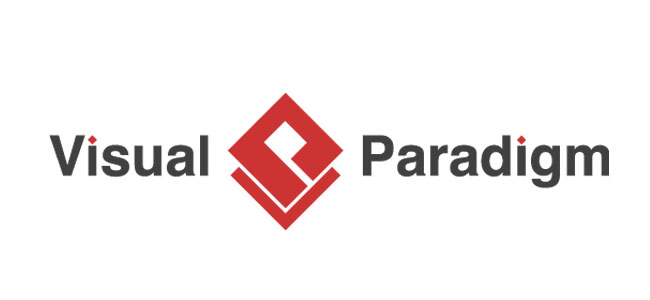
Visual Paradigm is an ideal modelling and diagramming tool which helps the product development team develop applications faster. Visual Paradigm is a cross-platform and powerful yet easy-to-use management and design tool for IT systems. The tool gives software developers one of a kind cutting-edge development platform to develop quality applications faster, better, and cheaper. It promotes outstanding interoperability with other CASE tools and most of the leading IDEs, which transcends your entire Model-Code-Deploy development process in this one-stop-shopping solution.
Features
- Visual Paradigm has a drag-and-drop diagram editor.
- This tool lets you export the database from Entity-Relationship Diagram (ERD).
- It includes REST API for devising a database.
- One can work with the team on the same project simultaneously. Teams can then evaluate their task before they start coding, which can significantly reduce the chance of having to backtrack once the cycle of product development ensues.
- Users can draw several types of Unified Modeling Language (UML) diagrams with this software owing to its easy-to-use templates. No artistic capability is required as all drawing functionality is incorporated in the app’s default toolkit.
- Visual Paradigm runs on Windows, macOS, and Linux OS.
5. SQL Database Modeler
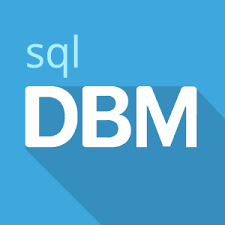
SqlDBM (SQL Database Modeler) is regarded as one of the best database diagram design tools which aims to provide a simple way to design your database on any browser. You do not need any other database modelling tools or database engines or apps to use this program.
Features
- SqlDBM enables you to import an existing database schema from other databases.
- You can run small and large databases and data models efficiently.
- Zoom-in or out diagrams is plausible and SqlDBM is equipped with two themes, dark and light.
- You can customize your project view with the help of modes like only description, table names, or keys only.
- SqlDBM permits you to move or copy columns across tables.
- It assists you to share the company’s projects with your colleagues.
- With the help of SqlDBM, you can create a physical model or ERD of your database.
6. DbSchema
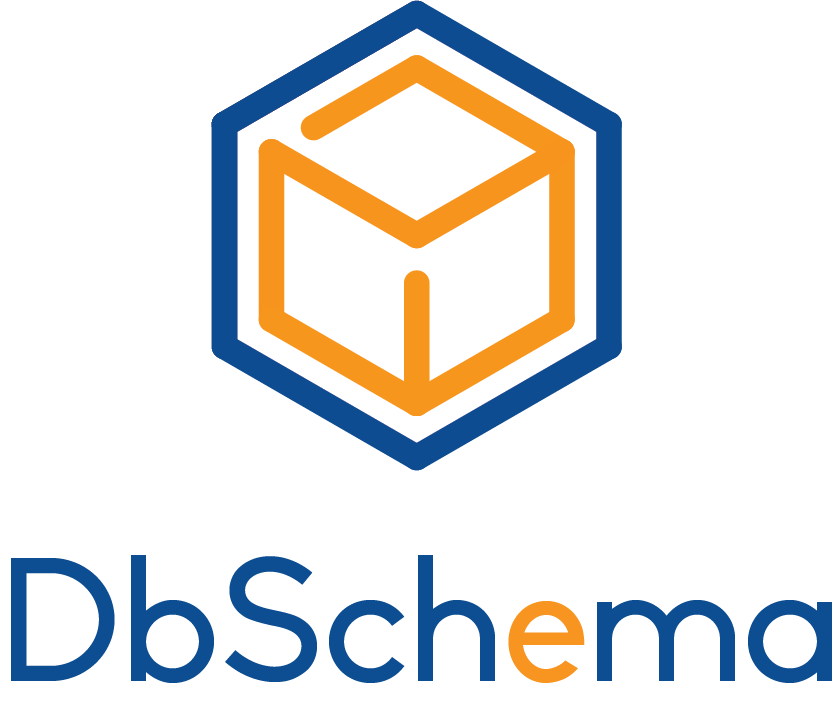
DbSchema is a visual database manager and designer for any SQL, NoSQL, or Cloud database. DbSchema supports all relational and No-SQL databases, which includes MySQL, SQLite, Microsoft SQL Server, PostgreSQL, MariaDB, MongoDB, Redshift, Snowflake, Google, etc. With the help of DbSchema, you can interact with the database using the mouse. Even though you are not an SQL expert, you can create new tables, or columns based on foreign keys or virtual foreign keys, create reports or generate test data and explore the data from multiple tables.
Features
- You can design the model without being connected to the database and the tool can be deployed on various databases.
- You can differentiate different versions of the schema and generate migration scripts
- Using DbSchema, you can create the tables in varied layouts, add comments, and generate PDF or HTML5 documentation.
- It includes a manageable designer for data analytics sheets and database reports.
7. Edraw Max’s Database Model Diagram

Edraw Max’s Database Model Diagram is considered one of the most reliable and fastest tools. It is both free as well as open-source used to create a Database Model Diagram. It is equipped with rich, precise, and pre-made shapes that make it effortless to complete jobs. The tool can be used to highlight a graphical representation of a database model and can break down the conceptual, logical, and physical model of a database. You can use an ER diagram to distinguish the common entities in a system and portray how they are related to each other. Additionally, it can also help you explore the tables saved in your database with respect to their attributes and relationships. Whenever you want to offer a blueprint of the database or its graphical representation, an ER diagram would come in handy.
Features
- The feature of drag-and-drop makes it user-friendly. The shapes are vector-based, which ensures that you can redesign them.
- This modelling tool is packed with advanced and automated functions that make customization effortless.
- This free tool also has some paid packages as well for users who seek more features.
- Excellent file compatibility enables you to export your drawings to a myriad of file formats, like PDF, Word, PPT, JPEG, Visio, Html, etc
8. Draw.io

Here’s another free tool that’s perfect for new users, Draw.io, the simplest way for Confluence teams to collaborate using diagrams. One of the more noteworthy usages of draw.io is the capacity to work in layers while creating your diagrams. Layers render a big boost of flexibility by enabling you to switch between several views of your diagram
Features
- Draw.io is compatible with all browsers like Chrome and Firefox and operates well on mobile devices as well.
- The tool has no limit on sizes. Additionally, it even allows users to decide where they wish to save the model. It has an ‘offline mode as well.
- You can choose from numerous readymade templates and make use of the drag-and-drop feature for quick results.
- The tool permits users to create a myriad of diagrams including ERD and UML.
9. PowerDesigner

PowerDesigner is known to be the best when it comes to complex data. PowerDesigner is one of the best industry-leading data modelling tools. It showcases a model-driven approach to empowering businesses. It allows companies to manipulate, analyze and visualize metadata for effective enterprise information architecture.
PowerDesigner blends different data modelling techniques to bring business analysis together with formal database design solutions. It works with more than sixty relational database management systems.
Features
- The free version of PowerDesigner comes with limitations but is quite simple to use.
- A few of its best features include link-and-sync technology and metadata management and the mapping editor is also quite fast. It can perform impact analysis and manage multi-model documents.
- The tools support 3 types of extensions namely .pdm, .cdm, and .bpm, and offer web-based reporting.
Conclusion
Data modelling is crucial to any business’ growth strategy. The best data modelling tools initiate manageable database schema design and a contemporary iterative approach. These tools facilitate organizations to process and analyze emerging types of data and future-proof their apps.
The above-listed tools are some of the most popular tools which simplify the process by reinforcing useful features. Apart from the ones we described, there are many more tools available so everyone can find their perfect commercial or open-source data modelling tool.
FAQs
Q.1: Is SQL a data modelling tool?
Ans: The cloud-based data modeller and database administration tool, SQL Database Modeler allows you to effortlessly design databases with the help of your web browser. You don’t have to install or configure any database drivers or tools.
Q.2: What are data Modelling techniques?
Ans: There are 5 different types of techniques used to organize the data:
- Hierarchical Technique
- Network Technique
- Entity-relationship Model
- Object-oriented Model
- Relational Technique
Q.3: What are the 4 types of data models?
Ans: The four types of data models include Hierarchical Model, Network Model, Entity-Relationship Model, and Relational Model


